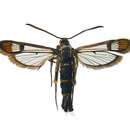Comprehensive Description
provided by Smithsonian Contributions to Zoology
Synanthedon tipuliformis (Clerck)
Sphinx tipuliformis Clerck, 1759:9, figs 1, 2
Synanthedon tipuliformis (Clerck)—Staudinger, 1901:401 [Refer to Dalle Torre and Strand, 1925:50–55, for a detailed bibliography]
MALE—Head with vertex brown-black; occipital fringe yellow, some brown-black mixed dorsally; antennae brown-black; front brown-black, white laterally; labial palpus smooth, yellow with broad brown-black band laterally Thorax brown-black; dorsally with very narrow subdorsal yellow stripes, and large patch of yellow beneath wing Abdomen dorsally brown-black, with segments 2, 4, 6, and 7 very narrowly banded yellow on posterior margin, yellow laterally on segments 1 and 2; ventrally brown-black; anal tuft fan-shaped, brown-black Legs yellow mesally; mostly brown-black laterally, with yellow laterally on forecoxa; tibiae with spurs yellow and yellow bands around tibiae at both pairs of spurs; tarsi ringed with yellow at joints Forewing mostly hyaline; relatively broad apical margin, large discal spot, veins and other margins brown-black with yellow powdered variously between veins and on anal margin; ventrally yellow powdering more extensive Hindwing hyaline; narrow margin and veins brown-black; costal margin yellow, and fringe near wing base pale yellow; discal spot small, triangular, brown-black Wing length of male, 7–8 mm Male genitalia (Figure 15) with valva having basal one-half of sacculus devoid of scales and without saccular ridge; remainder of elongate valva clothed with bifurcate scales except for patch of dark simple scales on ventral margin medially; saccus very short; socii relatively long
FEMALE—Similar to male except: abdomen with yellow banding dorsally only on segments 2, 4, and 6, anal tuft shorter, brushlike; forewing dorsally often with more yellow powdering on apical margin between veins Wing length of female, 8–9 mm Female genitalia (Figure 25) with ostium bursae at bottom of sclerotized U-shaped pocket-like area; initial posterior section of ductus bursae short, somewhat sclerotized, very narrow, tubular, with ductus seminalis arising at anterior end of this section, remaining anterior portion of ductus bursae elongate, slender, membranous, expanding somewhat to obovate corpus bursae
TYPE—Unknown
TYPE-LOCALITY—Unknown
HOST-PLANTS—Currant, gooseberry, and raspberry
DISCUSSION—The so-called “current borer” is a cosmopolitan species in temperate regions of the world where its host-plants have been introduced from Europe It occurs in New Zealand, particularly on South Island, throughout Tasmania, and coastal regions of New South Wales, and Victoria Apparently, specimens were first identified as S tipuliformis from New Zealand in an article by Thomson (1884) It has been known from Tasmania since 1917, and first collected in continental Australia in October and November 1926, in suburban gardens around Melbourne, Victoria (Pescott, 1935) The female moth deposits 20 to 60 eggs on young wood near the buds on the host-plant The newly hatched larva bores into the plant, feeding and maturing within the pith as it migrates downward in the cane The cream-white larva with brown head reaches a maximim size of about 13–15 mm in length, overwintering just prior to reaching this stage within the cane a short distance above ground level After some feeding in the spring of the year, the mature larva cuts a small, circular exit hole nearly through the bark and pupates The mobile pupa works itself out of the exit hole at the time of adult emergence Frequently, the pupal exuviae can be found protruding from canes of infected bushes
- bibliographic citation
- Duckworth, W. Donald and Eichlin, Thomas D. 1974. "Clearwing moths of Australia and New Zealand (Lepidoptera: Sesiidae)." Smithsonian Contributions to Zoology. 1-45. https://doi.org/10.5479/si.00810282.180
Synanthedon tipuliformis: Brief Summary
provided by wikipedia EN

Synanthedon tipuliformis illustration by
Des Helmore Synanthedon tipuliformis, known as the currant clearwing, is a moth of the family Sesiidae. It is endemic to the Palearctic realm, but is an invasive species in the Nearctic realm and the Australasian realm.
- license
- cc-by-sa-3.0
- copyright
- Wikipedia authors and editors



 Synanthedon tipuliformis illustration by Des Helmore
Synanthedon tipuliformis illustration by Des Helmore